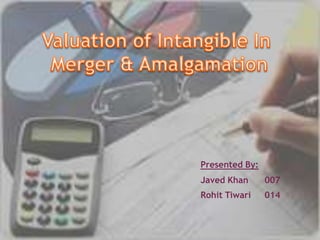
Valuation of intangible
- 1. Presented By: Javed Khan 007 Rohit Tiwari 014
- 2. Valuation is the process of estimating what something is worth. Items that are usually valued are a financial asset of liability. Valuation can be done on assets (for example, investments in marketable securities such as stocks, options, business enterprises, or intangible assets such as patents and trademarks) or on liabilities (e.g. bonds issued by a company). Valuations are needed for many reasons such as investment analysis, capital budgeting, merger and acquisition transactions, financial reporting, taxable events to determine the proper tax liability.
- 3. An asset that is not physical in nature. An Intangible Assets include: 1. Intellectual property Rights (Patents, trademarks, copyrights, software, database, trade secrets, know-how, registered designs, domain names) 2. Goodwill 3. Brand name An intangible asset can be classified as either indefinite or definite depending on the specifics of that asset. A company brand name is considered to be an indefinite asset, as it stays with the company as long as the company continues operations. However, if a company enters a legal agreement to operate under another company's patent, with no plans of extending the agreement, it would have a limited life and would be classified as a definite asset.
- 4. Valuation models can be used to value intangible assets such as patents, copyrights, software, trade secrets, and customer relationships. The value placed on intangibles assets, such as people, knowledge, relationships and intellectual property, is now a greater proportion of the total value of most businesses than is the value of tangible assets, such as machinery and equipment.
- 5. The International Valuation Standards Board issues Guidance Notes to guide experienced valuers on the application of the fundamental principles of the International Valuation Standards (IVS) to a spcific asset type or for a specific valuation purpose. IFRS 3, paragraph 13, and IAS 38, paragraph 34, requires that intangible assets arising from a business combination are recognised at their fair value. Some companies will recognise significant benefits by electing to adopt IFRS 3 retrospectively. You should seriously consider this election if: Your intangible assets are not currently reported on the balance sheet Intangible assets, particularly brands, are key business drivers. You made significant acquisitions of brands or other intangible assets in recent years You have good historic records
- 6. Valuations of intangible assets are required for many different purposes including: Acquisitions, mergers and sales of businesses or parts of businesses. Purchases and sales of intangible assets . Reporting to tax authorities. Litigation. Financial reporting.
- 8. There is consensus among valuers that there are three main valuation approaches when valuing intangible assets: Cost Approach Income Approach Market Approach
- 9. Cost based methodologies assume that the value of the asset is related to the costs incurred in developing or redeveloping it. While cost is not the same thing as value, it is an acknowledged benchmark for certain types of assets, typically software and workforces. Cost approach is generally the least applicable approach In the appraisal of marketing intangible assets’ and that ‘in many instances, the cost approach will underestimate the value. Overestimation is also possible, for example, if software projects get out of control, costs can rise, often in inverse proportion to the functional quality of the software. The cost approach may also be less applicable when the asset is old or unique, or hard to recreate.
- 10. In this approach, the value of the subject intangible asset is estimated as ‘the present value of the future economic income attributable to the ownership of the asset over its expected remaining useful life. This approach involves ascertaining the likely future income streams that would accrue to the owner of the subject asset and discounting these back to the date of valuation to reflect the time value of money and the risks associated with each income. It is generally held that, if the data are available, the most useful approach to valuing intangible assets is the income approach.
- 11. In this approach assets and transactions relevant to the valuation date involving assets that are similar to the subject asset are used as guidelines to estimate how the market might value the subject asset. If relevant data is available this must be considered. In the presence of good data the market approach is one of the most direct and systematic approaches to valuation, but it is frequently the case that relevant data is not readily available.